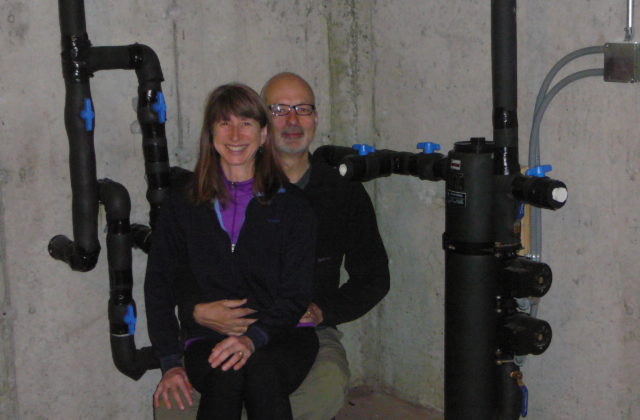Geothermal Systems Come to Norfolk
By Bob Bumcrot
Norfolk is not on a geothermal “hotspot,” like Iceland, where steam and superheated water can be easily extracted and used for heat and power, but like many parts of the earth, Norfolk sits atop its own virtually inexhaustible source of heating and cooling energy.
From about ten feet below the surface to several hundred feet down, the temperature of the rocks and soil is roughly 50 degrees, regardless of the time of year. The answer to the question of whether or not this resource can be used to help heat and cool our homes relatively cheaply, reduce our dependence on oil and decrease air pollution seems to be, “yes.”
Norfolk residents Elizabeth Knowles and Tom Murtha recently completed the installation of a geothermal system for their home on Laurel Way Extension. “It’s working very well so far,” said Murtha, “and we expect it to pay for itself in only a few years.”
The couple is pleased that by using much less fuel oil they will significantly reduce their Carbon footprint, an especially important feat as Murtha has just assumed a major position with The Nature Conservancy, the worldwide federation of conservation organizations. He will be working in Washington, New York and elsewhere to help large corporations act in environmentally conscious ways while still achieving their business goals.
With planning and design help from Peter Tavino, a Columbia-trained geothermal engineer from Litchfield, and after months of careful preparation, the Knowles-Murthas began the project. They hired Wragg Well Drilling of Roxbury to sink two 450-foot wells near the house, which hold about 1700 feet of grouted one and a quarter-inch plastic pipe filled with a mixture of water and propylene glycol.
Nutmeg Mechanical of Manchester then connected the pipes to an electrically-powered Climatemaster heat pump installed in the basement, which extracts heat from the ground in the winter and sends heat to the ground in the summer. The resulting heated or cooled air flows through the duct system that had been used by the old furnace. The existing oil-fired hot water heater is used as a backup heating system.
The cost savings, which may pay for the system in as few as six years, arise from a combination of the changes taking place in oil prices and electricity rates. While new sources of oil continue to be discovered, nearly all of them are more costly to recover and process than previously drilled spots. The expense of producing oil from tar sands and deep ocean drilling seems likely to continue in an upward progression.
On the other hand, regional natural gas developments have greatly reduced the price of natural gas in recent years. Since a lot of electricity in the area is generated from natural gas, rates have fallen and may continue to move in that direction. Within the last year, local electricity generation rates have decreased by about eight percent. The added electric cost of running the heat pump in geothermal systems is already substantially less than the cost of the oil that would have been burned in its place.
“Connecticut is the leading state in promoting growth of geothermal,” said Tavino, who is one of the top four trainers of geothermal technicians in the country. “Why use heat from oil drilled thousands of miles away when you can tap into the ground next to your house? Also, this puts money back into the American economy, much of it right around here.” The Climatemaster heat pump is made in Oklahoma.
There are currently two rebates available for a geothermal installation, a federal tax credit of 30 percent of the cost (offered through 2016), and a Connecticut Light and Power rebate of up to $1500, depending on the size of the system.
A serious investigation of geothermal installation should begin with a home energy audit and a load analysis. If a new duct system is needed, the time for the system to pay for itself will be longer than the Knowles-Murthas’ timeline. For further information on the installation process, go to www.LitchfieldGeothermal.com.

